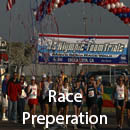How to Race - Race Preparation

Once at the Race Course
Once at the race site, there are a few last things to check off your to- do list. First and foremost, get to know the course. If your race is on a track, you have little to worry about. However, the majority of races today take place on a 2K or 2.5K loop course, with competitors repeating laps until they cover the total race distance. If possible, try to determine the locations of the 500M marks. These marks help you start the race on pace and maintain this targeted speed throughout. If there are no 500M marks, try to determine the loop’s halfway mark. Knowing what splits are available helps your preparation. Calculate and memorize the splits for your targeted race pace. At a minimum, know the splits for each lap. Ideally, by calculating and memorizing all the splits for the race, you enable yourself to precisely gauge your progress at all points during the race.
Remember the old adage, “The shortest distance between two points is a straight line?” It may be old, but it still holds true. When racing you almost always want to walk in the straightest line possible, (known as a tangent). The only exception to this is when the terrain along the straightest path is rough or banked heavily.
Many experienced walkers struggle determining the tangents. It’s a process that requires constant correction of your path. Observe the figure to the right that shows a sample racecourse and the proper tangent to walk. The course is measured along these tangents, so why walk the extra distance? Walk the course ahead of time, to determine the tangent lines and place them into your race strategy.

Pay careful attention to the tangents of the course.











